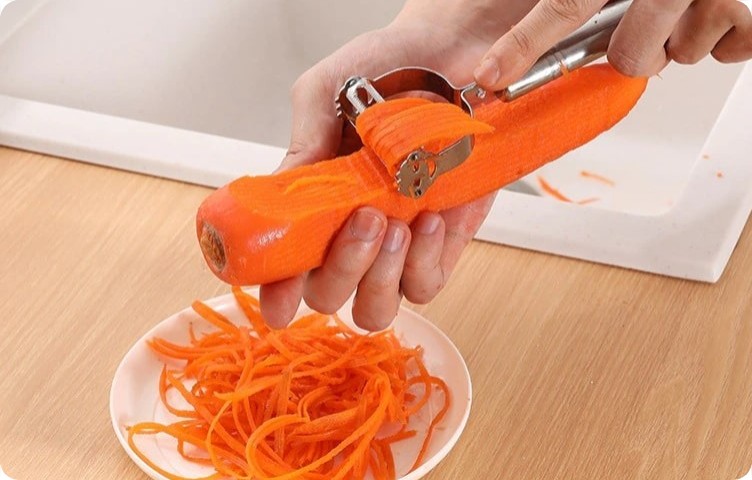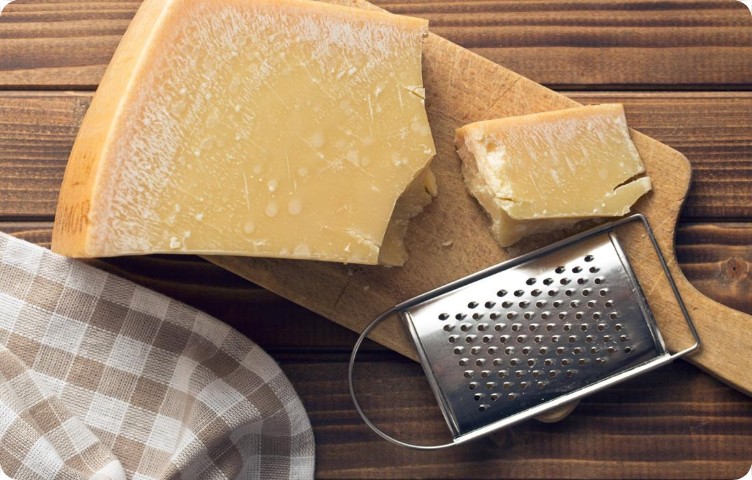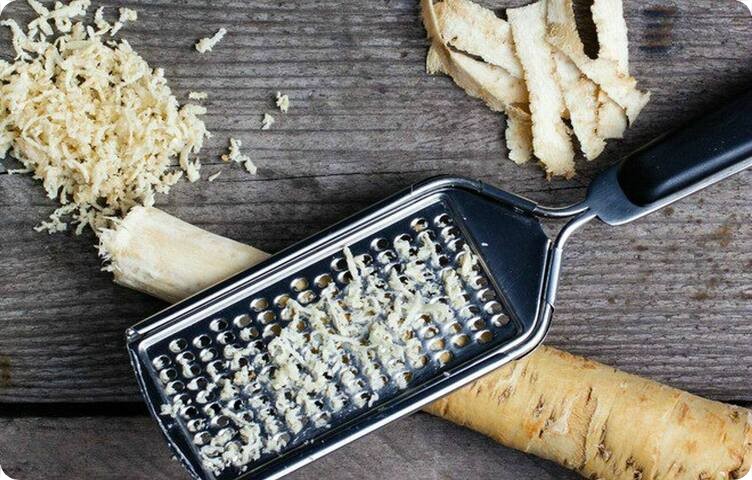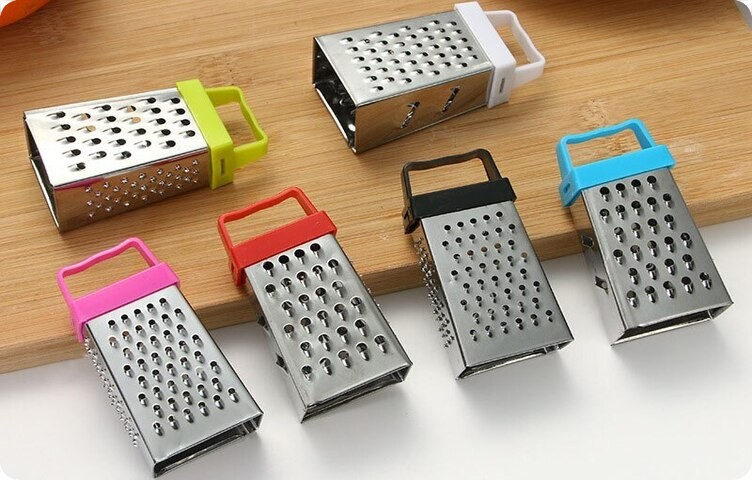Carrot salad, potato pancakes, macaroni and cheese - these and hundreds of other delicious dishes cannot be prepared without a grater . A convenient kitchen device with a serrated surface helps to chop food, cut it into thin strips, and remove the zest. Learn more about what type of tool you'll need for different cooking tasks.
Types of graters
An indispensable device that can now be found in any kitchen on the planet appeared 500 years ago. It was originally used only for grating cheese. Since then, dozens of models of graters have been invented, used for cutting vegetables and dairy products into shavings, strips and thin slices, chopping nuts and spices, creating purees and homemade pasta. Culinary experts classify them according to their purpose, design and materials.
Grinders have hundreds of uses, including grinding charcoal to add to barbecues and grating soap to create homemade liquid soap. Builders use a special plastering tool that is used to “rub” the surface of the plaster.
Purpose
In everyday use, the same device is used for different categories of products. But the shape and size of the holes in the saw blade indicate which textures they are intended for. Large slots are used for cutting into slices and strips, small teeth are used for grinding products into pulp. There are also special adaptations for specific products.
Universal grater for vegetables
This is a manual or mechanical device capable of processing various types of vegetables and fruits. It can be equipped with several working planes or attachments with different types of slots, including:
large “drops” - intended for chopping carrots, zucchini, apples;
small ones - help to grate potatoes onto potato pancakes, onions, carrots and beets for salads;
large oval ones - used for cutting even strips;
“thorns” - allow you to prepare puree from boiled vegetables for baby food;
curly teeth - used for chopping carrots, cabbage, cucumbers;
sharp blades - create thin slices for deep frying.
Multifunctional tools are also equipped with attachments for cutting cubes, shavings, and spirals.
Korean carrot grater
This kitchen appliance performs a single function - cutting long thin carrot strips. Since the root vegetable has a dense texture, the cutting part of the product must be very sharp.
There are several models of this type, ranging from a manual chopper with narrow slots to a mechanical chopper that resembles a meat grinder. The classic version is a rectangular tray with two panels with cutting holes built into the center. For harvesting large volumes of Korean carrots, an electric chopper with various attachments is recommended.

For puree
Using this device, baby food is prepared from fruits, berries and boiled vegetables. Many fruits oxidize when they come into contact with metal, so children's choppers are made from plastic. The hand tool is equipped with one or more plates with holes of different diameters. Pallets or containers are often included.
For Parmesan and other hard cheeses
Many dishes include cheese grated into fine shavings or thin slices. To grind it, a special tool is used - a plate with cutting holes, equipped with a handle. The slots, smooth on one side and pointed on the other, are arranged in even rows.
The convenient design allows you to grate Parmesan by holding it in one hand and the grater in the other. The sharp edge of the device is used to cut thin strips of cheese.
In addition to the classic one, there are three more models - box-shaped, in the form of a disk, and rotary, with a rotating handle. They are suitable for grinding any hard product, including gouda, cheddar, pecorino.

Shredder
The main task of this tool is to cut products into long strips 2-8 mm thick. There are two versions of the device - manual and mechanical. A manual shredder consists of a wooden or plastic body with oblong slits. The mechanical device operates by turning a handle and is equipped with nozzles of various widths. Using a shredder, you can cut potatoes for deep-frying, Korean carrots, and cabbage for fermentation. In addition to vegetables and fruits, the tool is used to obtain even strips of ham and cheese.
For ginger and citrus zest
Grinding spicesand peeling is a labor-intensive operation that requires care. The problem is easily solved by using a culinary accessory resembling a rasp file in shape. The long handle protects your fingers from damage, and the small teeth carefully remove the zest from lemons and oranges and turn ginger root into pulp.
The device is often equipped with a container for the crushed product. In addition to ginger, the “file” helps to quickly grate garlic, nutmeg, and cinnamon sticks.

Constructions
Experienced chefs distinguish more than 20 models of tools - flat, cubic, shaped like a mandolin, spatula, saucer. In a typical kitchen, the three most common types of graters are hand-held, tetrahedral and flat with removable panels.
tetrahedral
This device looks like a box with different sized slots on each side. The handle located on the top helps to hold the device during operation. With its help, you can chop food, cut it into thin strips, grind it into chips or puree. Boxed products are durable, easy to clean by hand and in the dishwasher, and are lightweight. They are suitable for preparing a variety of dishes, including salads, potato pancakes, zucchini pancakes, and desserts. The disadvantage of the product is that it takes up a lot of space in the kitchen.
With replaceable panels
This is a flat device made of plastic or wood with recesses into which cutting attachments can be inserted. The upper part of the product is equipped with a handle; holders can be provided for fixing to a bowl. The flat model is convenient because it simultaneously performs the functions of a shredder, chopper, and French fry knife. It is compact, light weight, and easy to use.
With a handle
A rectangular tool in the form of a spatula is equipped with a perforated blade on only one side. It is impossible to choose the size of the holes, as in the tetrahedral model, but it is convenient to grate directly into the bowl. The slits are usually large and very sharp. Therefore, you need to use such equipment very carefully so as not to injure your fingers.

Materials
Grater bodies are made of plastic, wood, and metal. Four materials are used for cutting parts:
- Stainless steel is durable, easy to sharpen, and has an aesthetic appearance. Used to make working blades for most graters. Box-shaped models are made entirely of stainless steel;
- plastic - does not oxidize food, therefore it is recommended for vegetable cutters and shredders. Easy to clean, lightweight, but dulls faster than stainless steel;
- bamboo - used to make Asian graters. The material is durable, lightweight, but delaminates from prolonged exposure to moisture. Bamboo choppers work best with tough, fibrous vegetables;
- porcelain - more often used for making graters in Asian countries. Such saucer-shaped products are used for grinding garlic, ginger, and spices.
The most practical option is stainless steel with a high chromium content.
How to choose?
When choosing a tool for your home kitchen, evaluate it according to four criteria:
functionality - if you like to cook, choose a tetrahedral model with holes of different diameters. For those who use a grater only for chopping cheese, a manual option is suitable;
safety - make sure that the product is equipped with a protective casing, rubber plugs around the edges and a non-slip handle;
ease of maintenance - the design should be simple enough to quickly remove food debris from the holes and rinse them;
convenience - choose a not too massive handle that fits easily in the palm of your hand.
A good option for those who prepare homemade canned vegetables is a mechanical model with several attachments.
Advantages and disadvantages of hand graters
If you need to grate a small amount of food for soup or salad, or make puree for your baby, there is no tool more convenient than a manual chopper. It is easier to wash after use and, unlike blenders and meat grinders, does not need to be taken apart. At the same time, rubbing takes a lot of time and effort, especially when working with hard products. Another disadvantage is the high risk of injuring your fingers.
Pros and cons of mechanical vegetable graters
A device with a rotating handle operates on the principle of a meat grinder. A variety of attachments allow you to cut food into strips, cubes, evenralami. The work does not require much effort and is completely safe for health.
The main disadvantage is the need to disassemble the device after use and wash the parts manually. Its use is justified only if you need to process a large number of vegetables at once, for example, for canning or jam.

Rules for caring for a grater
The tool should be cleaned immediately after use, before food debris dries in the holes. Rinse the item with hot water and dishwashing liquid, then wipe dry with a microfiber cloth.
If the slots are too clogged, clean them using an old toothbrush and detergent. Heavy stains are removed with half a lemon, which must be dipped cut side into fine salt. After smearing the product with salted lemon, leave it for five minutes, then rinse with hot water and dry with a soft cloth.
















































/https%3A%2F%2Fcomplexbar.com%2Fimages%2Fblog%2F58%2FCheese-grater1.jpg)
/https%3A%2F%2Fcomplexbar.com%2Fimages%2Fblog%2F245%2Fskov_glavn.jpeg)
/https%3A%2F%2Fcomplexbar.com%2Fimages%2Fblog%2F245%2Fhaiboli.jpg)
/https%3A%2F%2Fcomplexbar.com%2Fimages%2Fblog%2F245%2Fvilki-na-stole-752x480.jpeg)
/https%3A%2F%2Fcomplexbar.com%2Fimages%2Fblog%2F246%2F2024-04-09_17.22.54.jpg)
/https%3A%2F%2Fcomplexbar.com%2Fimages%2Fblog%2F246%2F2024-04-09_17.22.47.jpg)
/https%3A%2F%2Fcomplexbar.com%2Fimages%2Fblog%2F246%2FCODE_anons_foamydrops_752%D1%85480_eng.jpg)
/https%3A%2F%2Fcomplexbar.com%2Fimages%2Fblog%2F246%2FAlina_752%D1%85480_eng.jpg)
/https%3A%2F%2Fcomplexbar.com%2Fimages%2Fblog%2F246%2F2024-04-09_17.23.22.jpg)
/https%3A%2F%2Fcomplexbar.com%2Fimages%2Fblog%2F246%2F2024-04-09_17.23.28.jpg)
/https%3A%2F%2Fcomplexbar.com%2Fimages%2Fblog%2F246%2F2024-04-09_17.23.35.jpg)
/https%3A%2F%2Fcomplexbar.com%2Fimages%2Fblog%2F246%2Fdrinksome_752%D1%85480_eng.jpg)
/https%3A%2F%2Fcomplexbar.com%2Fimages%2Fblog%2F246%2Fnude_752%D1%85480_eng.jpg)
/https%3A%2F%2Fcomplexbar.com%2Fimages%2Fblog%2F246%2F752%D1%85480_eng__1_.jpg)
/https%3A%2F%2Fcomplexbar.com%2Fimages%2Fblog%2F246%2F752%D1%85480_eng.jpg)
/https%3A%2F%2Fcomplexbar.com%2Fimages%2Fblog%2F246%2FStudioRaw_752%D1%85480_eng.jpg)
/https%3A%2F%2Fcomplexbar.com%2Fimages%2Fblog%2F246%2FDoppio_tea_752%D1%85480_eng.jpg)
/https%3A%2F%2Fcomplexbar.com%2Fimages%2Fblog%2F246%2FTognana_Stars_Stripes_752%D1%85480_eng.jpg)
/https%3A%2F%2Fcomplexbar.com%2Fimages%2Fblog%2F246%2FRona_752%D1%85480_eng.jpg)
/https%3A%2F%2Fcomplexbar.com%2Fimages%2Fblog%2F246%2FDoppio_vending_752%D1%85480_eng.jpg)
/https%3A%2F%2Fcomplexbar.com%2Fimages%2Fblog%2F246%2FEssence_sukhie_smesi_752%D1%85480_eng.jpg)
/https%3A%2F%2Fcomplexbar.com%2Fimages%2Fblog%2F246%2FODK_sukhie_smesi752%D1%85480_eng.jpg)
/https%3A%2F%2Fcomplexbar.com%2Fimages%2Fblog%2F246%2Funiforma-barmena.jpg)
/https%3A%2F%2Fcomplexbar.com%2Fimages%2Fblog%2F246%2Fkak-nanyat-barmena.jpg)
/https%3A%2F%2Fcomplexbar.com%2Fimages%2Fblog%2F246%2Fsirop_scale_2400.jpeg)
/https%3A%2F%2Fcomplexbar.com%2Fimages%2Fblog%2F246%2FPeugeot_Anons_Paris_U%27Select_Line_Daman_752%D1%85480_eng.jpg)
/https%3A%2F%2Fcomplexbar.com%2Fimages%2Fblog%2F246%2Fkofe-vostochniy.jpg)
/https%3A%2F%2Fcomplexbar.com%2Fimages%2Fblog%2F246%2FMadler.jpg)
/https%3A%2F%2Fcomplexbar.com%2Fimages%2Fblog%2F246%2Fprofbartender_glavn.jpeg)